 Many of the email and marketing systems available today can do a lot of marketing work for you. These systems have features such as forms to capture leads, automatic replies, and even customized follow-ups. These sophisticated, integrated tools are changing the way businesses prioritize their marketing efforts. By knowing what stage of the buying process your customers are in, your sales team can focus on the lower-hanging fruit and your marketing team can focus on everyone else. Continue reading “Three Systems that Help Convert a Lead into a Customer”
Many of the email and marketing systems available today can do a lot of marketing work for you. These systems have features such as forms to capture leads, automatic replies, and even customized follow-ups. These sophisticated, integrated tools are changing the way businesses prioritize their marketing efforts. By knowing what stage of the buying process your customers are in, your sales team can focus on the lower-hanging fruit and your marketing team can focus on everyone else. Continue reading “Three Systems that Help Convert a Lead into a Customer”
Blog
Tips to Convert an Online Lead into a Sale

Lead generation means taking leads—potential clients and customers—and nurturing them in the right way so that you can convert them into actual clients and customers.
In the past, we’ve talked about having unique landing pages on your website that tie in with your social media outlets; somebody who gives their information on your website is a hotter lead than someone you make a cold call to. Arguably, the person who volunteers their information to you could be a better lead than a referral, because they clearly want something from you—and they have already taken the time and made a leap of faith to give you their information. Continue reading “Tips to Convert an Online Lead into a Sale”
Building a Brand: Online Advertising Tips

Online advertising can be a very powerful tool for the construction industry. Companies such as Google and Facebook provide a lot of information about how to utilize their online advertising services. However, as these services have expanded and diversified, they have also become a bit complex. Continue reading “Building a Brand: Online Advertising Tips”
Which Social Media is the Right Social Media?

In just a short time, social media sites (e.g., Facebook, Twitter, Instagram, LinkedIn) have evolved to become crucial tools used by professionals to market their services, build their collaborative networks, and achieve their goals. Thoughtful, strategic use of social media enables construction businesses to highlight their successful projects, showcase their services, and promote their expertise.
At first, the variety of social media options can seem intimidating, but once you familiarize yourself with a few of them, you’ll understand which can be of most help to you. Continue reading “Which Social Media is the Right Social Media?”
Laying the Groundwork for the Right Website

Professionals in the construction industry are experts at turning ideas into plans and plans into buildings—as well as other projects that are beautiful, useful, and durable. But the old rules about marketing your skills and services have been upended, and it is no longer optional to recognize the role that websites, social media, and smart technology now play in finding your next customers—or in helping your next customers find you.
Does your company have a website?
Continue reading “Laying the Groundwork for the Right Website”
Hyperlocal Marketing – Just Hype?
When trying to determine the best marketing strategy for the growth of a company, it’s easy for a business owner to become disillusioned by the “mythology” of corporate marketing. You tentatively adopt a strategy, “do it,” and are not sure if it works, and, if it does, you have no idea why. There are so many jargon-heavy terms floating around, it can be hard to parse through what works, and what is just a red herring.
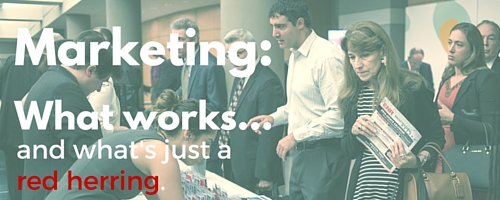
Larger, online-based companies have adopted the term “hyper-local” to refer to the complicated algorithms and expensive analytics that help them target the customers they want with mobile and online ads. It’s important to remember that for You, the small business owner, “hyper-local” marketing is just plain…Marketing! You are already targeting the right customers at the right time by being in touch with your audience through customer service and sales.
But First, Take a Step Back
 It’s still necessary, however, to develop a solid understanding of the relationship between your brick-and-mortar or e-commerce space and its online footprint. It’s always important to ask yourself the big questions before deciding where to dedicate your time when building your strategy:
It’s still necessary, however, to develop a solid understanding of the relationship between your brick-and-mortar or e-commerce space and its online footprint. It’s always important to ask yourself the big questions before deciding where to dedicate your time when building your strategy:
- What is your brand?
- What is your brand’s voice?
- Who is your audience?
- How do you communicate your brand to your audience?
- How does this communication turn your audience into customers?
And, in the internet age, importantly:
Where are your customers searching for your product or service online?
(Of course, if you have troubles answering these questions, don’t hesitate to reach out!)
Never Ignore Your Website
It’s easy to misunderstand the importance of a business website when online review sites such as Yelp or Google Business seem to build customers for you. Your website should not be just a sales channel for your product or service, but should work alongside your existing online presence (read: your Yelp reviews!) to be an extension of your company’s brand into the virtual space. Once you’ve created a strong business website, consider the way people are entering it.
- If people are being funneled through backdoor channels (such as the aforementioned Yelp reviews) are they staying?
- How well is your website doing in Google search rankings?
- If you are spending money for online ads, are people clicking on them?
- Are you using mechanisms like special offers for conversions?
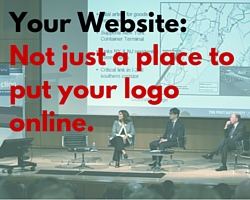
The goal is to be specific with your audience. If you are not sending the right person to the right page, be ready to deal with a high bounce rate. Try utilizing unique landing pages with customized copy when doing local campaigns, so you can geo-target potential customer bases for events or conferences. Once they’re on your site, get them to stay with the key to all successful online marketing strategies: content!
Share what you do with your customers, and your website will become a dynamic part of your marketing strategy, not just a place to put your logo online.
The Right Focus on the Right Channel
Once you’ve built a strong website and begun to establish your online presence, it’s time to start experimenting. Set up Google analytics and test different channels until you start to understand the DNA of your local customers. When you figure out which channel your audience is using to communicate, you can know better where to allocate your resources. Take advantage of all social media outlets, but, depending on your industry, be sure to find the right blend.

- Don’t waste money on Facebook ads being seen by random audiences.
- Don’t direct people to a webpage that’s not targeted to them.
- Don’t spend hours on your Twitter account if your customers are talking about you on Yelp.
- Don’t have an Instagram account just…because you feel like you have to have one.
- Don’t spend money (& time!) to find customers instead of spending money for customers to find you!
The beauty of online is that you can switch things quickly if you see it’s not working.
Join the Conversation & Develop Your Voice
If you are doing a good job, allow your audience to speak for your business. Your continued great online reviews give strength to your online presence.
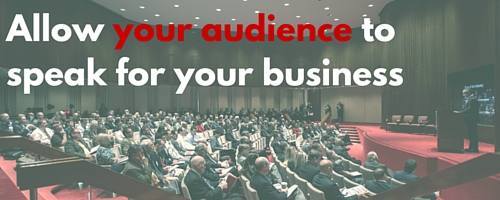
If you don’t like what your customers have to say, however, join the conversation! If you engage your “haters,” you still have an opportunity to turn a negative experience into a positive one. When you delight your customers, word of mouth will spread quickly. When it does, be ready with a solid website and brand presence! The combination of your active efforts as well as the inactive work done by your adoring audience will build the best representation of your business online.
Let your “hyper-local” marketing efforts go global and turn curious converts into lifetime customers.
Full Service Event Management
 Not an event planner
Not an event planner
When you hear “event management,” you may think of companies that can book your hotel stay, handle food and beverage, print name badges, coordinate senior management’s travel, and so on. But there are other areas of conference- and event-management that are increasingly being outsourced—and for good reason.
What people often don’t consider is the “meat and bones” that make up the actual conference. This includes programming the content and selecting speakers for industry-specific conferences, creating and implementing a multi-tiered marketing plan and budget, as well as managing the entire sponsorship sales process.
I have recently been approached several times over the past few months for help with conference-sponsorship sales. In these discussions, I have heard that it is very hard for clients to find a company that specializes in such, which was an interesting insight.
At The Karlyn Group, we are finding that many companies (typically publishers) simply aren’t able to handle all aspects of an event internally. Their marketing and sales teams, while skillful, don’t know where to begin. Many of these organizations are used to dealing with magazine audience development, writing proposals, or selling advertising in print and online. And they don’t realize that an event budget is often entirely separate from those other activities. Finding an audience that is looking to attend conferences, or—even more so—sponsor events, can feel like finding a needle in a haystack.
Typical Conference Work
Event programming: this can be an industry term, but “programming” involves researching a topic, looking at the competitive landscape, surveying the industry, creating a positioning paper and, from there—fleshing out an event agenda and recruiting speakers for sessions. The sessions can involve case studies, panels or keynotes, depending on the event. And speakers should ALWAYS be thought leaders; people who are well known in their field and are not vendors looking to make a sales pitch.
Event marketing
This isn’t too far off from other kinds of marketing. But you need to make sure your messaging is targeted and your lists are segmented. For a potential attendee, a conference is not mandatory, and it is often hard for them to take time out of the office. So it’s critical that your programming strike on a pain point for its intended audience…something they will learn, someone they will meet, professional learning credits they will receive, or the opportunity to get work. Creating a multi-channel plan is most important because you will have to reach these potential attendees often. Using only mail, or email, or social media won’t cut it. You need a blend of all of the above, and you need to be very creative on how you do it.
Sponsorship Sales
If you know how to do this, you are one in a million. It is very tedious and time consuming to find out who controls this budget, and then determine who will part with precious funds to put it toward your event. At The Karlyn Group, we work on events that sell out, which are rare, and even then it takes a lot of convincing (and multiple conversations). Not unlike other sales, you have to form very strong relationships with prospects and clients and stay in touch even when you don’t have events happening. You also have to be prepared to create customized packages with nearly every sale…ROI controls the success of the deal. Make sure you have a great CRM system, so you can be strategic on how you are reaching your prospects, and how often.
There are a lot of moving parts to events, conferences, banquets, user forums, etc. Without a clear understanding of each part of the business, it is hard for companies to know if they can handle this work internally.
If you have an idea, or an event/conference you need help with, don’t hesitate to call us for a free consultation…we have a very successful track record and have exceeded our goals continually. We love what we do, and we love our clients.
More on us here.
A Happy Customer is Yours for Life
How to get new traffic to your store (or site) and grow your loyal customers.
Today’s customers want it all – competitive pricing, value, and high quality service. What’s more, loyalty levels are declining leading to higher turnover rates. A customer is four times more likely to buy from a competitor because of service quality as opposed to price (Bain& Co). Thanks to social media – the ultimate in word-of-mouth communication- individuals decisions to switch can have rapid and widespread consequences (Accenture).
Providing your customers with useful information will build loyalty.
Content marketing is all about creating and distributing relevant articles, information, videos, etc. – to attract and engage a clearly defined target audience. The end goal is to drive profitable customer action.The idea is to create interesting content that speaks to clients and prospects without selling them anything overtly. Packaging and disseminating useful content in a thoughtful way also positions your store as a thought leader and showcases your expertise. Modern consumers are more shopping savvy than ever as the internet provides easy accessible information about your product and those your competitors are selling. While determining what customers are looking for is crucial, meeting their needs is not enough to keep them coming back.
It is important to build loyalty through time and build trust.
Learn more about your most loyal customers and enthusiastic promoters, those who love doing business with you and sing your praise to others. Invite your top clients back to your store using feedback surveys and conversations. Highlight your unique strengths that attracted them in the first place.
Ensure the support of senior leaders and managers to help ensure that all team members recognizes the importance of your customer service philosophy. Empower your staff to make decisions in-line with your customer service culture. “Our standard return policy was 30 days but the owner always told us we can break the rule when we felt it would make customer service sense,” Tina, a sales associate at Moss and Me, told us. “I knew giving back a customers money would have her spend more in the store, and she did that day!” Success requires cultural change and commitment to permanent customer service values first.
Recognize that not all customers are the same. While customer value and profitability are key elements of the company’s retention tactics, set rules around customer service means you are more than likely not adapting to the needs of each customer. Listen to a individual needs and provide a solution tailored specifically to the situation.
Always stay on your toes. Older businesses are in danger of becoming complacent, allowing their innovative capacity to die off. When long-time consumers are only contacted for business they are likely to see your relationship as a formality and take their business elsewhere. Remember, competitors are courting new customers just as often as you are, if not more. Bringing new benefits to your customers and making the business relationship about more than a discount will keep your old buyers coming back. A good way of doing this would be to:
- Work with agencies like the Karlyn Group to create a newsletter for your clients which highlights the differences between products or services.
- Have a productive website which encourages repeat business.
- Offer informal classes, book signings, and demonstrations by vendors.
No matter what stage your business is in, there are simple ways for you to build your relationship with your consumers and continue to thrive.
Branded Content: It’s Not Just for Big Brands or Big Budgets: Small businesses can leverage branded content to great advantage
The idea of “branded content” often conjures up images of expensive marketing campaigns with Hollywood-style treatments. So to a smaller business, the concept may feel daunting. But the reality is that branded content can run the gamut of scale and budget; the most important thing is to do it well. And for a small business, a well-thought campaign can utilize branded content to great effect.
In this post, you’ll learn:
-What’s the big deal about branded content?
-Where to begin your own branded content efforts
Why all the fuss about branded content?
As defined by the Branded Content Marketing Association through commissioned research, branded content is “any content that can be associated with a brand in the eye of the beholder.” In that light, branded content is obviously of the utmost importance as it encompasses the entirety of your marketing efforts, and beyond.
More specifically, “branded content” often refers to something purposefully created by a brand in order to entertain or educate its target audience. It is intended to create positive feelings about a company, product, or service without going in for the hard sell—and it is often designed to encourage and facilitate sharing. It may use images, characters, and storylines that are clever, surprising, or touching, which aim to win over the viewer or reader.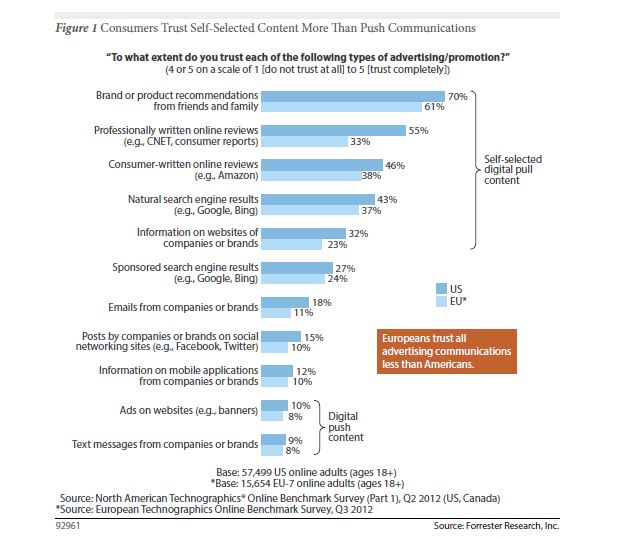
This more nuanced type of branded content may seem less traditional than a straightforward campaign with a “buy now!” punch line, or one that aims to tout a product’s superior attributes. But it still relies on age-old tenets of marketing and holds distinct powers of persuasion. By leveraging branded content’s softer-sell approach, a smaller company can build awareness, goodwill, and its customer base.
Where do I begin?
Myth: branded content has to be complicated. Not true; in fact, simpler is often better. Before you even start to think about what should be written, filmed, designed, or produced—take a minute to put yourself in the shoes of your customer or potential customer.
Ask: what type of information and education would be useful to your target audience? (Some answers may seem beyond the scope of your company’s knowledge base or expertise—but don’t discount these ideas off the bat; there may be something to them.)
Next, figure out your goal for the branded content campaign. Do you seek increased visitors to your homepage or social media pages? Increased awareness of your brand in the marketplace? More leads? Sign-ups for a free download or trial?
Once you determine the type of content that makes the most sense, and what you’d like readers/viewers to do as a result, think about what channel(s) would be most logical (keeping your budget in mind, of course). For instance, maybe your company has some relevant and compelling data that would lend itself to an infograph treatment. Or maybe a short video would help bring your customer’s needs to life.
Then, execute. And if you don’t have internal resources that can help to produce the branded content you want, look to outside firms who can work within your budget to provide something new and fresh that resonates with your target audience.
You may even want to partner with an organization or association to bring their content to your audience. Here’s a secret: you don’t have to create all of your branded content from scratch; instead, find clever, visual ways to repurpose existing information or leverage your company’s relationships to solicit shareable, relevant content.
Once you’ve launched your campaign, monitor and measure its results—and have a strategy in place to ensure that your campaign doesn’t get stale. If you get in the habit of regularly offering topical, helpful content to customers and prospects, your brand will start to become a trusted and ongoing resource for them.
Also, make sure you get the word out so your branded content can work best by linking other marketing functions to your content. You can push out teasers from social media, email campaigns, and other digital outlets that can then point back to your site or wherever the content lives. At times, you can push people to a landing page that is more targeted to the audience you are reaching, making your campaign more successful.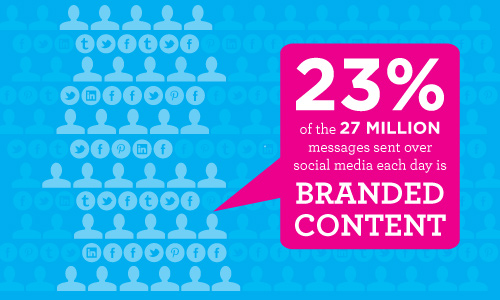
Tips and reminders
Forrestor Research reminds us that branded content “is designed to build brand consideration and affinity, not sell a product or service.” The good news is that customers generally trust and respond well to this type of content. Recent research from Vibrant Media showed that advertorials ranked higher as a useful source of information than journalist-written articles. And one in three respondents rated an advertiser’s own website as the most useful source of information about a product, with particular receptivity to content delivered in an image-based format.
As noted by Joe Palazzo, founder of the Content Marketing Institute, in 2012: “The future of the marketing department is half content and half publishing.” That future is now. The key is thinking smart about your branded-content campaign and leveraging resources beyond the four walls of your own company. And never lose sight of your audience and what sorts of information they need and want. So, start small, and you’ll go far! Smaller businesses can have just as much—or more—success with branded content as their larger peers. Good luck!
by Amy Zucchi-Justice, Co-Founder & Head of Marketing and Strategy, The Karlyn Group.
Amy Zucchi-Justice is an experienced marketer and sales professional specializing in media, events, product creation and launches—as well as creating successful growth-oriented branding campaigns.
The Importance of Face-to-Face Events
In today’s business world the prospect of hopping on a plane or even cabbing it down Madison Avenue seems absurd. Business dealings are conducted almost entirely through technology, with even the occasional phone call seeming alarmingly personal. While conducting business through technology may seem more efficient, these proceedings may have lost some of the most crucial elements of good business – interpersonal connections.
Face-to-face events allow for individuals to make eye contact, smile, gain trust, and demonstrate commitment to the relationship through physical actions such as handshakes. Achieve Solutions establishes that these sensory bonds allow for better assessments of people and situations, and ultimately stronger business connections. Based off this information the meetings industry has designed a long-term promotional campaign in order to increase knowledge of the importance of face-to-face events according to High Point Enterprise.
What are the Key Outcomes of Face-to-Face Contact?
Face-to-face contact is critical for relationship building. It is important to utilize face-to-face contact in order to share information, enable collaboration, build trust, and to get all parties involved with the business proceedings on the same page.
As company travel budgets are rapidly shrinking, it is important to determine when face-to-face contact is really the best investment.  Often during virtual meetings attendees are distracted and multitasking, leading to lower productivity according to The Maritz Institute. Face-to-face interaction allows for attendees to maintain focus and to interact with the speaker and each other.
Often during virtual meetings attendees are distracted and multitasking, leading to lower productivity according to The Maritz Institute. Face-to-face interaction allows for attendees to maintain focus and to interact with the speaker and each other.
In a study conducted by Meeting Focus, it was illustrated that more ideas were generated with face-to-face contact. It is easier to negotiate ideas without miscommunication, as well as exchange confidential information.
When is Face-to-Face the Best Investment?
Face-to-face communication is the best investment when there is a risk of business being lost. Meeting Professionals International (MPI), reports that 40% of prospects converted to new customers via face-to-face meetings, and 28% of current business would be lost without face-to-face meetings. Re-establishing trust and security through face-to-face communications can strengthen a faltering relationship.
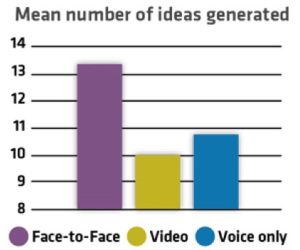 For example, at this women’s conference organized by the Karlyn Group, a networking event was set up in order to allow for women to create meaningful business connections. Speakers sold their books, snacks were served, and women had a chance to engage in face-to-face interaction with each other. As opposed to a web seminar, where contact is terminated at the conclusion of the event, the women who attended this conference have continued to attend in subsequent years, and have reported increased business success.
For example, at this women’s conference organized by the Karlyn Group, a networking event was set up in order to allow for women to create meaningful business connections. Speakers sold their books, snacks were served, and women had a chance to engage in face-to-face interaction with each other. As opposed to a web seminar, where contact is terminated at the conclusion of the event, the women who attended this conference have continued to attend in subsequent years, and have reported increased business success.
 Face-to-face interactions are not only important for one on one meetings, but can be beneficial for larger groups. Face-to-face interactions can also increase the attractiveness of a meeting or event, especially when the destination is set to be someplace inviting to guests. Holding meetings in unique settings such as on a boat or a bowling alley can engage attendees in new ways. These types of events facilitate team building and increase office morale. While these types of meetings may be more costly, they yield higher rewards as relationships are strengthened and productivity is increased. In the Fearless event pictured to the right, The Karlyn Group partnered with POKERprimaDIVAS to uniquely merge business with pleasure. This event showed attendees how to sharpen their skills needed in the deal-making environment by practicing the game of poker with a great group of professionals. Women bonded, made connections, and built business relationships in a unique and fun environment. Amy Ecolino a senior manager from McGraw Hill Financial reported having “made real relationships with real people, instead of feeling like I was simply another icon on their computer chat”.
Face-to-face interactions are not only important for one on one meetings, but can be beneficial for larger groups. Face-to-face interactions can also increase the attractiveness of a meeting or event, especially when the destination is set to be someplace inviting to guests. Holding meetings in unique settings such as on a boat or a bowling alley can engage attendees in new ways. These types of events facilitate team building and increase office morale. While these types of meetings may be more costly, they yield higher rewards as relationships are strengthened and productivity is increased. In the Fearless event pictured to the right, The Karlyn Group partnered with POKERprimaDIVAS to uniquely merge business with pleasure. This event showed attendees how to sharpen their skills needed in the deal-making environment by practicing the game of poker with a great group of professionals. Women bonded, made connections, and built business relationships in a unique and fun environment. Amy Ecolino a senior manager from McGraw Hill Financial reported having “made real relationships with real people, instead of feeling like I was simply another icon on their computer chat”.
Co-Owner of The Karlyn Group Amy Zucchi-Justice feels “Nothing can replace the face-to-face interaction you get with people at events. We are all so busy that we rely on email, texting and social media so much that we don’t form relationships with people as easily anymore. Events are a great way to bring people with similar backgrounds together and have them network with one another”. Regardless of the convenience of technology, the human essence provided by face-to-face contact is irreplaceable when creating strong business relationships.
Are you Ready to make connections? Contact the Karlyn Group today to find out how we can help you plan your next face-to-face event.



